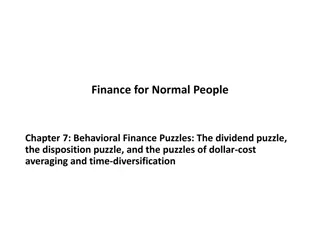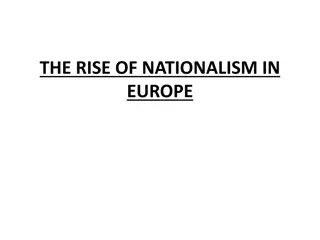French Productivity Puzzle: Unraveling Insights
This research paper delves into the perplexing productivity trends in France, offering valuable insights from leading experts. Through a comprehensive analysis, key factors influencing productivity levels are explored, shedding light on potential solutions. Findings from the CEPREMAP Productivity Project will be discussed, providing a basis for understanding and addressing the challenges faced in the French productivity landscape.
Download Presentation

Please find below an Image/Link to download the presentation.
The content on the website is provided AS IS for your information and personal use only. It may not be sold, licensed, or shared on other websites without obtaining consent from the author.If you encounter any issues during the download, it is possible that the publisher has removed the file from their server.
You are allowed to download the files provided on this website for personal or commercial use, subject to the condition that they are used lawfully. All files are the property of their respective owners.
The content on the website is provided AS IS for your information and personal use only. It may not be sold, licensed, or shared on other websites without obtaining consent from the author.
E N D
Presentation Transcript
Exploring the French productivity puzzle Philippe Askenazy (CNRS-PSE, Cepremap and IZA) Christine Erhel (University Paris 1, CES, CEE) With the contribution of Martin Chevalier (ENS Cachan) CEPREMAP Productivity project, Paris conference, 23rd of January 2015
Introduction Labour productivity relatively high in France, and quite dynamic until 2007 (OECD data). A reversal in 2007-2009, followed by a limited increase in 2010-12 and flatness in 2013-14. Large contrast with previous recessions. Does it result from short-term factors or does it indicate a change in the French productive model (high job protection, labour costs, high work intensity and productivity)? Changes in labour market (e.g. labour supply composition, reforms altering labour law, pensions)?...
Introduction Structure of the chapter/presentation 1. The French productivity puzzle 2. A new labour market (A) and supported firms (B) 3. Quantitative micro-analyses using establishment/firm data
1-The French productivity puzzle Figure 1: Quarterly GDP, employment and working time indexes. 1990-1997 and 2006-2013. Base 1 = Q1.1992 (t=0) or Q1.2008 (t=0) . INSEE NA 1.1 1.08 Value-Added 1992 recession 1.06 Value-Added 2008 recession 1.04 Employment 1992 recession 1.02 Employment 2008 recession 1 Working time 1992 recession 0.98 Working time 2008 recession 0.96 0.94 -8 -7 -6 -5 -4 -3 -2 -1 0 1 2 3 4 5 6 7 8 9 10 11 12 13 14 15 16 17 18 19 20 21 22
1-The French productivity puzzle In comparison to 1992-1993: huge differences in GDP trends but similarity in (un)employment trends and flatness in working hours => under-adjustment in (un)employment and slowdown in productivity per head during the 2007-2009 crisis Facing this puzzle, the most straightforward explanations do not seem significant The drop in productivity, that concerns only the market economy, cannot be explained by particular industries A slowdown in real wage growth, but no adjustments that could explain employment (and unemployment) trends A stability of investment, and of R&D spending during the crisis
2a-A new labour market Changes in the composition of the workforce are large Increase in seniors employment rate following pensions reforms: effect on productivity is unclear A continuous decrease in employment rates for the middle educated, whereas they increased for the higher levels of education. An acceleration of the shift of labour demand from the low or middle educated to the most educated during the recent recession Could explain up to half of productivity slowdown over the last years. Why?
2a-A new labour market Employment for top salaries occupations and top education level, 1000 workers, 1990-2012 (source: INSEE) 6,000.0 5,000.0 4,000.0 3,000.0 Upper tertiary Managers and professionals 2,000.0 1,000.0 0.0 Top occupations or educated doubled their weight in total workforce Employment growth for top occupations and upper-tertiary educated is a-cyclical like long-term investments Generate apparent pro-cyclical productivity
2a-A new labour market Low and middle educated face still business cycle, while no correlation between the evolution of high-educated workforce and GDP growth 5 10 4 8 3 6 2 4 1 0 2 1990 1992 1994 1996 1998 2000 2002 2004 2006 2008 2010 2012 -1 0 1990 1992 1994 1996 1998 2000 2002 2004 2006 2008 2010 2012 -2 -2 -3 -4 -4 g secondary or below Gdp growth g high-educated gdp growth
2a-A new labour market A rise of low productivity jobs favoured by some labour market reforms: Increase of very short term contracts since 2004. Continued after the introduction of an extra social contribution in 2013. Could contribute to productivity slowdown. New self-employed status in 2009: most of them have low revenues and are less productive than classic self- employment who was sharply declining. Rough estimation shows it could explain one fifth of productivity slowdown.
2a-A new labour market Non-salaried employment, total hours worked by the self-employed, and mixed income of unincorporated enterprises, 2003-2013. Volume base 1 = 2007 1.1 1.05 1 Mixed income Hours Jobs 0.95 0.9 0.85 2003 2004 2005 2006 2007 2008 2009 2010 2011 2012 2013 Source: Authors' computations using National Accounts, base 2010. Mixed income of non-corporate business is deflated by the price index for the total value added. The vertical line dates the creation of the auto-entrepreneur status.
2b-..and supported firms No clear evidence of credit rationing or change in tangible capital allocation in France. Financial situation of firms has been sustained by various policies. >>> a global analysis shows that changes in labour force composition and labour market regulation may be the most important drivers of the productivity slowdown. But the links micro determinants of productivity (e.g. work practices) and their evolutions also have to be taken into account, using micro-data.
2a-A new labour market and supported firms Corporate loan stocks and loans drawn by SMEs Millions of current Euros. 2006-2014 180000 160000 140000 120000 SMEs more than three years old 100000 80000 60000 SMEs less than three years old 40000 20000 0 2006Jan 2006Sep 2007Jan 2007Sep 2008Jan 2008Sep Source: Bank lending survey. Banque de France. 2009Jan 2009Sep 2010Jan 2010Sep 2011Jan 2011Sep 2012Jan 2012Sep 2013Jan 2013Sep 2014Jan 2006May 2007May 2008May 2009May 2010May 2011May 2012May 2013May
3-Micro-analyses using REPONSE Databases and methodology A merged dataset: REPONSE (2005 and 2011, panel), composition by occupations, job creations/destrubctions (DMMO-EMMO), firm accounts Analysis is based on total factor productivity estimations Ln(labour productivity) = .ln (Capital intensity) + .Workforce composition + .HR-Practices + .controls + Cross-section, panel, IV A nested logit deals with the more specific issue of skilled labour hoarding in firms where employment has been declining (using REPONSE 2011)
3-Micro-analyses using REPONSE Results (1): labour force composition and productivity No significant effect of seniors share on productivity in 2011, and no statistical difference in coefficients between before and after reforms According to REPONSE 2011, skilled occupations have been maintained in a majority of establishments experiencing a decline in employment: some skilled labour hoarding during the crisis. Such labour hoarding appears related to some firms strategic goals (especially innovation) Some indications that higher short-term contracts churning rate would no longer be associated with a higher productivity, suggesting a change in the use of CDD that may hamper productivity >>>these results are consistent with our general macro-estimations
3-Micro-analyses using REPONSE Aged workers or skilled occupations and apparent labour productivity Dependent variable: ln(value added per employee) (1) (3) (5) (6) 2005 2011 2011 Declining 0.32*** (0.06) 0.08 (0.20) 0.27 (0.27) 2011 Non-declining 0.29*** (0.02) -0.32 (0.21) 0.36*** (0.11) Ln(Total assets per employee) 0.32*** (0.03) -0.41* (0.23) 0.27* (0.15) 0.30*** (0.03) -0.24 (0.16) 0.26** (0.11) Share of employees aged 55- Share of high-skilled occupations Ref.= share of medium-skilled Controls: Establishment age, pct. of women, pct. of low-skilled, 2-digit industry, firm size R Yes Yes Yes Yes 0.60 0.62 0.67 0.65 N 1591 1938 595 1341
3-Micro-analyses using REPONSE Results (2): work practices and productivity High involvement dimensions include employee shareholding and organised voice. High performance management, job rotation, autonomous workteams. No changes in the correlation between performance practices and productivity between 2005 and 2011; In 2005, organised voice and employee shareholding were associated with higher productivity. In 2011, no significant relationships for these variables practices: quality >>> a break in the impact of high involvement practices on productivity after the 2008 shock? E.g. consistent with the drop of stock markets (still 30% below the pre-recession level)
3-Micro-analyses using REPONSE Work practices and productivity Dependent variable: ln(value added per employee) (1) (2) (3) (4) (5) 2011 2011 2011 2005-2011 Panel 0.340*** (0.056) -0.022 (0.025) -0.009 (0.049) 2011 Mono-est. 0.284*** (0.028) 0.004 (0.040) 0.038 (0.028) 0.000 (0.038) -0.077*** (0.028) -0.043 (0.041) Relative productivity Ln(Asset/employee) 0.302*** (0.028) 0.004 (0.026) -0.033 (0.023) -0.020 (0.011) -0.041** (0.020) -0.010 (0.019) 0.361*** (0.044) -0.003 (0.025) -0.040 (0.026) 0.006 (0.024) 0.000 (0.000) 0.008 (0.017) Organized voice (+) ns Empl. shareholding (-) ns Quality management (+) ns Autonomous team (+) ns Job rotation (-) ns Organized voice in 2005 0.004 (0.029) 0.080 (0.055) Employee shareholding in 2005 Ln(Productivity per employee in 2005) Ln(Asset per employee in 2005) 0.550*** (0.059) -0.264*** (0.047) Yes Yes 1426 0.71 2-digit industry Other controls N R Yes Yes 1857 0.63 Yes Yes 717 0.61 Yes No 530 0.60 Yes Yes 2569 0.03
Conclusion Main factors explaining France productivity slowdown according to our analysis: -development of low productive jobs, in relationship with labour market reforms; -increase in high-skilled labour force resulting in less employment reactivity facing a recession; -lower performance of high involvement practices. A revival is possible the two last factors might be transitory if the European macroeconomic environment moves.























